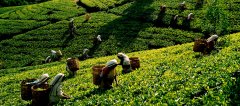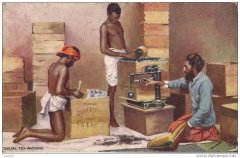Where can I buy authentic Sri Lankan Ceylon black tea? How to cook Ceylon black tea without astringency
What kind of Ceylon tea is best with iced tea? Now that you know how easy it is to brew cold, you may be tempted to prepare iced tea at home. Looking for the best Ceylon tea to make iced tea? Almost all kinds of tea-black tea, green tea, white tea and brewing tea-can be used to make iced tea. However, we strongly recommend some stronger teas to make iced teas. Let's have a look. 1. Pure Ceylon green tea with iced tea pure Ceylon green tea is yellow and has a slight baking flavor. It has the smell of herbs and earth. Although this kind of tea itself is very suitable for making iced tea, Ceylon green tea is the most suitable tea. Ceylon green tea combines rich pineapple and tropical fruits such as strawberries, mangoes and peaches, setting off the taste of green tea. With the fresh aroma and fresh taste of tropical fruits, it is very suitable for making iced tea. two。 Pure Ceylon black tea with iced tea is the most popular preparation base of iced tea. In the brewing process, many other fruits and spices can be added. You can even choose different kinds of black tea in the market. Ceylon black tea brewed with peaches and ginger is a good way to make iced tea. The sweetness of peaches brings balance and calmness to the spicy taste of black tea and ginger. How to tell if your Ceylon tea is pure? After Sri Lanka became independent, many people wanted to get rid of the colonial history and stop using the name Ceylon. By that time, however, the name had gained such a good reputation that stopping using it could mean a serious retrogression in growth. Therefore, although Sri Lanka became independent in 1948, the name "Ceylon tea" is still in use today. This has led to the creation of a priceless world brand that has become a symbol of quality assurance. As Ceylon tea is becoming more and more popular, it has become important for the Sri Lankan Tea Committee to set quality standards. "Pure Ceylon Tea-Sri Lanka Packaging" has become the trademark slogan of Ceylon tea. The use of logos and slogans is closely monitored by the Sri Lankan Tea Bureau to maintain the quality standards and reputation of Ceylon tea in the international market. In order to experience the true taste and flavor of Ceylon tea and get all its benefits, be sure to buy only pure Ceylon tea with the lion logo and trademark slogan on the package. There are many rules to follow if you want to become pure Ceylon tea. Tea must be grown and harvested entirely in Sri Lanka. The Sri Lankan tea board enacts all laws and ensures their compliance. For example, Ceylon tea cannot be mixed with any other form of tea. Even 95% of mixed tea does not count as Ceylon tea.

Where can I buy Ceylon tea? Like most natural products, fresh tea tastes best. However, most teas on the market are far from that. It takes nearly a year for them to reach your cup through a supply chain of middlemen and warehouses. When your tea takes a long journey from the plantation to your home, it will gradually fade and lose its natural flavor and aroma. As a result, some ordinary tea brands use chemical methods to add natural and artificial flavors or genetically modified tea. Unfortunately, most of today's leading tea brands (some of which may be in your kitchen cabinets) contain harmful chemical additives to improve the taste and shelf life of tea. This is achieved by eliminating middlemen and purchasing directly from the best real estate factories in Sri Lanka. Their real-time demand algorithm allows them to order tea supplies only when needed, reducing inventory and waste. Sri Lanka is the only country where tea is grown all year round, so we do not need to stock tea for off-season orders. Teakruthi offers only the best pure Ceylon tea, picked by hand, and comes from selected plantations in Sri Lanka's high, medium and low growing areas. Our experienced tea tasters carefully balance its complex tastes and aromas to create a series of unique flavors. We process tea in a climate-controlled facility and seal them in an aluminum bag to protect them from sunlight. Therefore, your tea is fresh and the real taste and aroma are complete.
Important Notice :
前街咖啡 FrontStreet Coffee has moved to new addredd:
FrontStreet Coffee Address: 315,Donghua East Road,GuangZhou
Tel:020 38364473
- Prev

Seven tea-producing regions of Sri Lankan black tea introduce where Lipton Ceylon black tea and milk tea are specially produced.
The tea area of Ceylon did you know that 4% of the land in Sri Lanka is a tea garden? Anyone who really loves Ceylon tea knows that every tea producing area in Sri Lanka produces tea with its own characteristics. Tea is grown in seven regions of Sri Lanka. They are different from each other because they are all at 3000 to 8000 feet.
- Next

Where does Wuwa black tea come from? What is the difference in taste between Wuwa black tea and Ceylon black tea?
How is Ceylon tea grown? The method of growing tea at equal height is used in Sri Lanka. In contour planting, tea trees are planted along the contours of the land, usually on slopes. More than 1 million people in Sri Lanka are engaged in tea cultivation because the planting process requires too much labour. This process needs to be ripe.
Related
- What is the standard process for the purpose of coffee cup testing? What is the difference between hand-brewed coffee and cup testing?
- How to use hand-brewed coffee paragon small golden balls? How does cold coffee lock in the aroma of coffee?
- Is American coffee black? What is the difference between American coffee and drip coffee?
- Unexpected! Well-known tea beverage brand Lele Tea will withdraw from the Zhengzhou market!
- Starbucks enters the fashion and beauty industry?! Netizen: Give me an ice American eye cream
- Why can American refills for free? The difference between Americano and American drip pot coffee
- Being chased out of the rain in front of Starbucks?! Store: Sheltering from rain under umbrellas poses a safety hazard
- The white moonlight has changed?! Lucky launches "Big Winter Pear American"
- Hand-brewed coffee three-stage method, high-sweet and universal brewing method to share! What does the high sweet water level of hand-brewed coffee mean?
- What is the difference between raw, refined and full espresso coffee? How to extract espresso and taste good?

